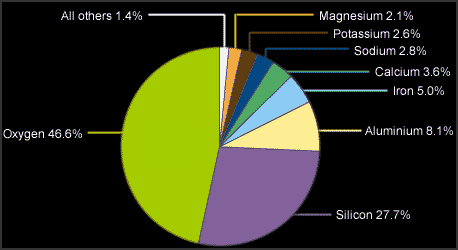The Earth Contents
1. Structure
The Earth's crust is very heterogenous
Oxygen makes up nearly half the crust, and almost all of this is combined with silicon in different proportions to form silicate rocks. Silicon, iron and aluminium together make up a further 40% of the crust, and another 10% is due to calcium, magnesium, potassium and sodium. Many familiar metals (e.g. lead, copper) are too scarce to be shown separately and only constitute part of the remaining 1.4%. It is worth noting that if the composition of the atmosphere and the hydrosphere are included, then the percentages given here change only slightly!

The continental crust we can see is composed of a mosaic of different rock types; igneous, metamorphic and sedimentary, but with a bulk composition which approximates to that of granite (an igneous rock). By contrast the crust which underlies the oceans is of basaltic composition (again, an igneous rock). Compared to granite, this is enriched in iron, calcium and magnesium, and depleted in silicon, potassium and sodium.
| Granitic continental crust | |
|---|---|
| Oxygen | 46.9% |
| Iron | 2.9% |
| Silicon | 33.2% |
| Magnesium | 0.7% |
| Aluminium | 7.7% |
| Calcium | 1.9% |
| Sodium | 2.9% |
| Potassium | 3.2% |
| Others | 2.7% |
| Basaltic oceanic crust | |
|---|---|
| Oxygen | 44.5% |
| Iron | 9.6% |
| Silicon | 23.6% |
| Magnesium | 2.5% |
| Aluminium | 7.9% |
| Calcium | 7.2% |
| Sodium | 1.9% |
| Potassium | 0.1% |
| Others | 2.7% |
Which elements make up the majority of the Earth's crust?